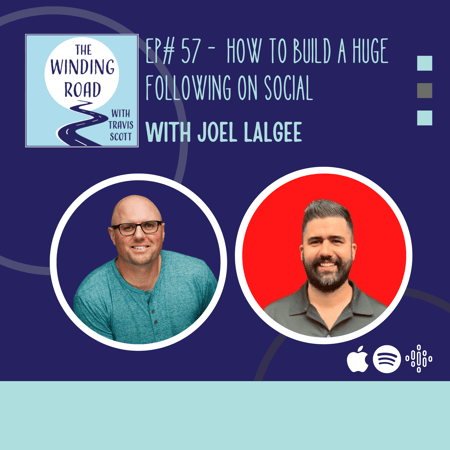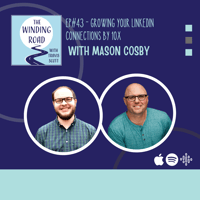I was able to sit down with another repeat guest, Mason Cosby. Whenever we get together, we don't...
Growing and Monetizing Your Social Following with Joel Lalgee

Three years ago, Joel Lalgee decided to go 'all-in' on social- the results have been mind-blowing.
By now, you've probably heard people talk about the huge followings they've been able to achieve on TikTok in a short amount of time by taking advantage of the social platform being in it's somewhat early days. What about doing the same thing on a more mature social network like LinkedIn that's been around since before Facebook?
In just over three years, Joel Lalgee has grown his LinkedIn following to over 190,000. Growing your audience size this large doesn't go unnoticed. LinkedIn has noticed as have others and he's now able to monetize his social following. In the world of monetizing content eyeballs are everything.
Think You're Late to the Game? You're Not
But, the interesting thing is, Joel didn't build this audience up over three years a while back. He did it in the past three years.
Yep, you read that right. The past three years. On a social network that has been around since 2002. So, if you think it's too late for you to get started, you're wrong. But, you have to start now.
Whether you want to build a huge audience in an attempt to monetize it or you want to become more well known in your industry to open up more career prospects, growing a targeted audience will be important.
Building the Right Audience
LinkedIn allows you to have 30,000 1st connections. That seems like a lot but, quality matters more than quantity because engagement of your content is what will fuel the growth of our followers.
What's the difference between connections and followers? Connections are people you've sent a connection request to or who have sent one to you, and you become a first connection allowing you to freely message them and see more profile information.
A LinkedIn follower is someone who isn't a direct connection but who has elected to follow you by clicking the 'follow' button on your profile. This allows them to see the content you post without being directly connected to you on the platform.
When you're just starting to build your following on LinkedIn, you'll want to be intentional about who you directly connect with. It's important to find people in your industry or market so your content will resonate and gain more traction through engagement like comments, shares, and likes. Even when someone clicks the 'see more' link in a post, that counts as an engagement.
Joel decided to prune his direct connections to get rid of the random connections that weren't in the sphere of what he was going to talk about. One thing to note, you can remove a direct connection but they can still follow you, which is fine.
This allowed him to free up connections for people who were part of his target audience.
Another important element, is to follow (or you can try to connect with) people who have large followings of your target audience. This will be important for gaining visibility as you start to focus more on engaging with others, not just posting.
When you're sending out connection requests, try to max out your weekly requests. No one really knows how many connections requests you can send out each week, but it's in the ballpark of around 100. So, start out with a goal of sending 20 connection requests each day during the week.
Not everyone is going to accept your request and that's fine. Don't take it personally. Some people aren't very active on LinkedIn- something like around one-third of LinkedIn's users aren't active.
Building Personas
Before you begin connecting, you'll want to identify your target audience. Building personas is a great way to do this. A persona is a short representation of key elements of the type of person you want to connect with- or in marketing who you want to attract.
For Joel, he wanted to reach more hiring leaders in talent acquisition so he started connecting with them directly. Another strategy was to get in front of his target audience by connecting and engaging with the people hiring leaders were connected to - their employees. Which, in this instance were recruiters.
He thought, if he could create content that generated a lot of engagement among recruiters, that would build credibility and attract the hiring leaders he was targeting.
Grabbing Their Attention
Joel says one of the things he realized early on is that "...you've gotta be able to grab their attention and hold it for a really long time." This is why building a network made up of your target audience is going to be critical because they should be interested in what you have to say and, will be more likely to engage with your posts and content than someone not in your field or market.
Quality of your content matters, but don't let this hold you back early on. There's no such thing as the perfect post and sometimes, the thing you think is awful gets the most engagement and the thing you thought was fantastic gets crickets.
You never know, so just post.
Leading with a 'hook' that grabs someone's attention quickly - they're scrolling and you want to stop their scroll- is going to be important.
Not sure how to do this? Pay attention to people like Joel who get a ridiculous amount of engagement on their posts and, as Austin Kleon suggests, "steal like an artist." What this means, is start to copy the format that these people use. Do you notice a certain structure to their posts? Which posts get the most engagement? Why do you think that is? Can you create something that will help people do their job better?
Once you start noticing what others are doing, you'll eventually find your own voice and format that becomes uniquely you. But first, you have to start someone and just getting started is often the hardest part of doing anything.
How Often Should You Post?
This is a common question. Unlike Twitter, where you can post many times per day and not see any downside - in fact it probably helps- LinkedIn's algorithm works differently. If you post within 19-24 hours of your last post, LinkedIn will tend to not show them to as many people. They don't want a few people clogging up everyone's feed.
So, when you're starting out, it might help to build up your posting cadence more slowly. You can start by posting three times per week - weekends actually aren't a bad time to get noticed since fewer people post but quite a few people are still scrolling then.
Eventually, you can build up to once per day, but that's all you should do.
Engaging with Others is Where Most People Fail
One of the keys to Joel building his impressive following has been a focus on engagement. So often, people will post something then drop the mic and walk away. People will comment but the post's author is no where to be found. Ghosting your commenters is a great way to ensure that your post will wither and die on the visibility vine.
Your engagement with people commenting on your post is an important factor LinkedIn's algorithm considers.
It's also important to comment on other people's posts- especially if they have a large following. By doing this, you'll be able to pick up followers from these posts and grow that way. If you're following influential people and are able to comment shortly after it's been posted you increase your chances of that author of that post replying to you, which can be a great way of building trust with their followers and attracting them to follow you.
This is something a lot of people ignore.
In a previous interview with Emily Mireault, she talked about the importance of 'living in the comments' and wished she had done more of it when she was building a network to find her next job.
What if They Ban TikTok?
TikTok has been a great way to build a large following quickly - Joel has grown his following in a very short time.
But, recently there has been talk about the US government banning TikTok - Montana just passed a resolution to ban TikTok in the state (not sure how that will work, but I travel to Montana frequently and will be curious to see if I can access TikTok once the ban goes into effect).
What about the time that Joel has spend figuring out what works on TikTok? Will that be a sunk cost and a complete waste of time?
Joel doesn't think so. Especially since most of the other social platforms including Instagram, Twitter, and YouTube, have adopted the short video format of Twitter and engineered it's reach in a similar way.
He'll just take what he learned from creating content on TikTok and apply it to Instagram Reels or YouTube Shorts.
But, this is a good lesson in the difference between renting your audience through social and owning your audience through a list you've build for email marketing and newsletter-type content. Eventually, you'll want to do both.
Start Now
Hopefully, this has convinced you to get off of the sidelines and into the game when it comes to building a following on LinkedIn. The power of networking and engaging with people on a platform like LinkedIn can have a tremendous impact on your career trajectory. Just ask Joel, Emily, or another past guest, Mason Cosby.
Don't wait though. The noise is only going to increase and it will only become more difficult to be seen and heard. Being strategic about how you build an audience and who you engage with will be an important factor to how quickly you can get up and running and start seeing the benefits of your growing professional network.
You may not be able to get to a following of 190,000 like Joel and monetize it, but you'll monetize it in different ways-specifically when it comes to your career.
Are you looking for a job and feel like you need some guidance? I offer new way of coaching using asynchronous voice messaging. If you'd like to tap into my experience of being a former recruiter along with my deep understanding of marketing careers, consider my 6- week coaching program.
-1.png?width=400&height=100&name=Website%20Logo%20-%20400x100%20(transparent%20background)-1.png)

